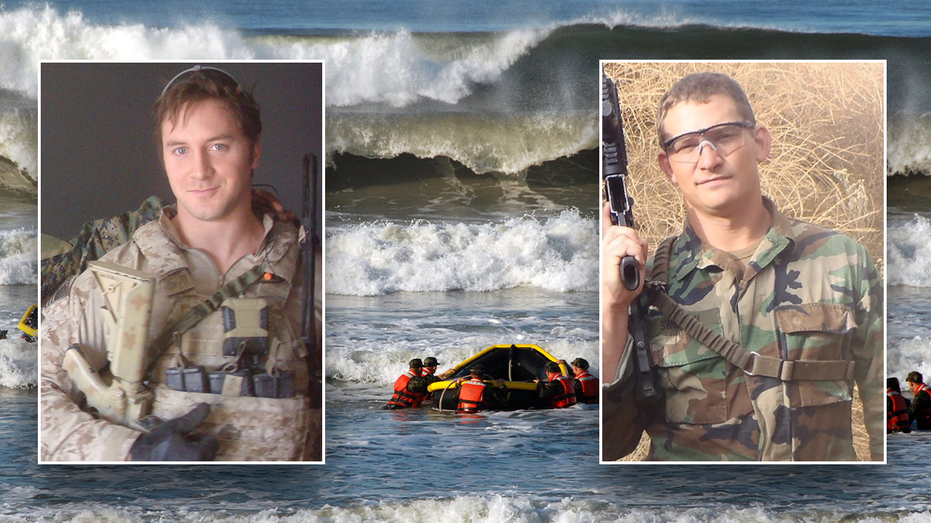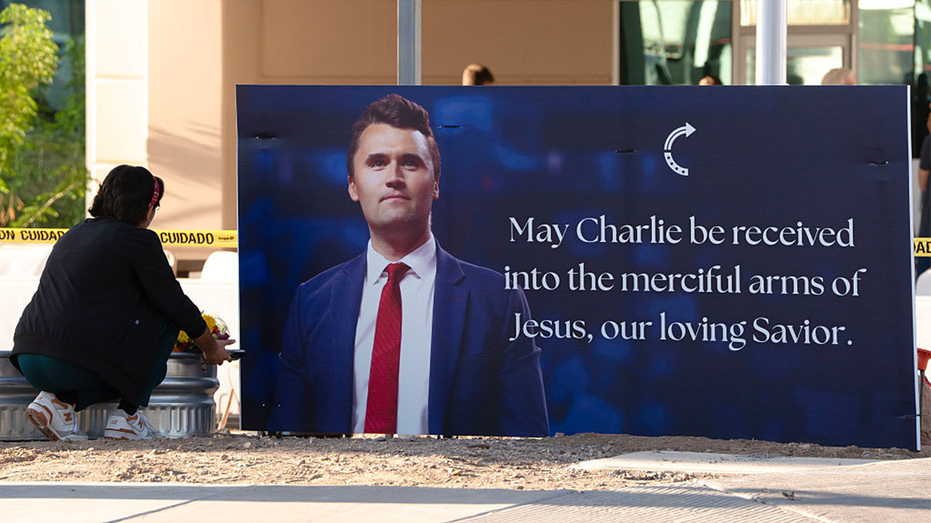Mexican sewage gushing into Navy SEAL training waters is US’ ‘next Camp Lejeune,’ vets warn

“Disgusting,” said Navy SEAL veteran Rob Sweetman in describing the smell and mist of Mexican sewage spewing into U.S. waters as he stood on a hill overlooking the Tijuana River estuary in California.
Sweetman, a Navy veteran who served on the SEALs for eight years, spoke to Fox News Digital to sound the alarm on a water crisis rocking the San Diego area, including where SEALs train, taking a camera with him to show viewers firsthand how the contaminated water flows into the U.S.
Just one mile away from where Sweetman spoke, SEALs and candidates train in the same water, which has sickened more than 1,000 candidates in a five-year period, per a Department of Defense watchdog report released in February.
San Diego and the surrounding area are in a clean-water crisis that has raged for decades, but it is finding revived concern from the Trump administration as SEALs and local veterans warn of a “national security crisis” that they say is on par with the Camp Lejeune, North Carolina, water crisis.
Thousands of Marines and others were sickened at North Carolina’s Camp Lejeune base between 1953 and 1987 as a result of water contaminated by industrial solvents used to drink, bathe and cook at the training facilities and on-base housing.
EPA CHIEF TAKES ON MEXICAN ‘SEWAGE CRISIS’ FLOWING INTO US WATERS WHERE NAVY SEALS TRAIN
Kate Monroe, a Marine Corps veteran and CEO of VetComm — which advocates for disabled veterans and those navigating the VA’s complicated health system — told Fox Digital in an April Zoom interview, “San Diego County is as big as some states. It’s giant. Millions of people live here and are breathing the air of this water. It goes well beyond the military. It’s a crisis. It’s a FEMA-level travesty, and we have just been hiding it.”
The Navy has deep roots in the San Diego area, with the United States Naval Special Warfare Command headquartered in America’s Finest City and where Navy SEAL candidates complete their arduous six-month Basic Underwater Demolition/SEAL (BUD/S) at the Naval Amphibious Base Coronado.
The sewage problem flowing from neighboring Mexico into the U.S. has percolated in San Diego for years.
But the water crisis hit crisis level when it was reported in 2024 that 44 billion gallons of contaminated water imbued with raw sewage was released along the California coast in 2023, the most on record since at least 2000, the Los Angeles Times reported at the time.
The issue of sewage water flowing into U.S. waters is largely attributed to outdated wastewater infrastructure across the southern border, local media outlets recently reported, with Mexico reportedly in the midst of addressing its infrastructure to curb the leaks of sewage water.
The Tijuana River has for decades been plagued by sewage and waste that has affected its beaches and neighboring San Diego.
In February, the Department of Defense’s inspector general released a report finding that the Naval Special Warfare Center reported 1,168 cases of acute gastrointestinal illnesses among SEAL candidates between January 2019 and May 2023 alone.
“Navy SEAL candidate exposure to contaminated water occurred because (Naval Special Warfare Command) did not follow San Diego County’s Beach and Bay Water Quality Program’s beach closure postings,” the inspector general report found. “As a result of Navy SEAL candidate exposure to contaminated water during training, candidates are presented with increased health risks and NAVSPECWARCOM’s training mission could be impacted.”
It was when Monroe, who is well-versed with veteran health through VetComm, was working with SEALs who were retiring that she realized the severity of the San Diego water pollution of the past few years.
She observed an increase in health claims related to intestinal issues and “weird cancers,” which was a departure from typical claims related to PTSD or orthopedic ailments.
US SENATOR BLASTS PRESIDENT OF MEXICO, SAYS TOXIC SEWAGE DUMP THREATENS ‘NATIONAL SECURITY’
“I started creating relationships with the SEAL teams, the people that were exiting the SEALs, you know, at 14 years, 20 years, nearing their retirement,” Monroe told Fox News Digital. “And the claims that we were making for these guys were surprising to me because a lot of them, they have combat PTSD, a lot of orthopedic issues. But we were having guys coming to us with, like, IBS, GERD, skin issues, weird cancers, and they were all attributing it to their time spent in San Diego training to be a SEAL in that water here that we have in San Diego.”
Swimming and spending time in water contaminated with feces can lead to a host of illnesses, including bacterial, viral and parasitic infections that leave people nauseous, vomiting and rushing to the bathroom.
Navy SEAL vet Jeff Gum was only days from entering the SEAL’s aptly named Hell Week — the fourth week of basic conditioning for SEAL candidates — when nausea hit him. He was trapped in a cycle of drinking water and vomiting when he realized a serious illness had its grips on him.
Gum is a retired SEAL who served from 2007 to 2017 and was exposed to the contaminated water in 2008 during BUD/S training off the San Diego coast.
“I couldn’t stop,” Gum recounted of how he couldn’t keep water down without vomiting. “You never really want to go to medical because they can pull you out or make you get rolled to the next class, but I couldn’t even drink water without throwing up. It’s the only time in my whole life that this has happened.”
Gum’s nausea overcame him on a Friday in 2008, with Hell Week kicking off that Sunday night. Hell Week is a more than five-day training that puts candidates through rigorous training, including cold-water immersion, “surf torture,” buoy swims, mud runs, all while operating on minimal sleep.
SAN DIEGO SUBURB FACES ‘SEWAGE CRISIS’ FROM LOCAL BEACH
“The sun goes down, and the instructors come out with big machine guns, that kicks it off,” Gum said of how Hell Week began. “We run out to the beach, right into the ocean. You spend the rest of the week soaking wet, covered in sand. And everywhere you go, you have a 200-pound boat on your head that you and your boat crew of six to seven guys will share the weight of, and you just run everywhere.”
“You’re just in the water. There’s no escaping it. It’s part of what makes BUD/S BUD/S. And it’s part of what makes the Navy SEALs America’s premier maritime special operators,” he said. “There’s not getting around how comfortable we have to be in the water. Cold, wet, miserable, doesn’t matter, we suck it up and we do it.”
MEXICO IS POISONING SOUTHERN CALIFORNIA IN A BORDER CRISIS ALMOST NO ONE KNOWS ABOUT
Gum received IVs the weekend ahead of Hell Week and was able to keep food and water down by the time the intense training began, but he had been diagnosed with viral gastroenteritis, commonly known as the stomach flu and highly contagious, which then morphed into rhabdomyolysis due to exerting so much energy while dehydrated from viral gastroenteritis
Rhabdomyolysis is a serious illness that causes muscle to break down quickly and can lead to “muscle death” and the release of high levels of myoglobin in the blood that can injure a person’s kidneys.
Gum failed the first phase of BUD/S, but he was granted permission to return to training for a second time after senior leaders saw he had viral gastroenteritis. Gum again went through the first phase of BUD/S, but again he went to medical, where tests showed that his “blood came back toxic” from rhabdomyolysis.
The SEAL was put on medical leave and able to fully recover in his home state of Pennsylvania before he “crushed” the hellish training on his third try. He served on SEAL Team Five, deployed to Fallujah, Iraq, and taught combatives and prisoner handling to SEAL trainees in San Diego from 2013 until his retirement in 2017.
Sweetman told Fox Digital that “everyone who goes through training is going to get sick.”
“They’re going to get infections, and it’s terrible,” Sweetman told Fox Digital in an April Zoom interview. “And some might argue that this is Navy SEAL training. You have to go through the toughest conditions to be able to survive and make it. I would say that it’s gotten a little bit out of hand.”
The SEAL vet, who lives in the San Diego area, said the issue has gotten worse in recent years as Tijuana’s population grows.
I TRAINED WITH THE NAVY SEALS FOR A DAY. THIS IS WHAT I LEARNED
“When I went through training, it was absolutely a thing that they’d shut down the Imperial Beach because the ocean water was so bad, because the waste coming from Tijuana had infected the water,” Sweetman said. “You could always smell it. And oftentimes, even in the bay, we’d need to wash our wet suit after being out on a swim.”
“Now, some of the training causes us to be deeply immersed in the water, and infections and all types of things can come up from being in the water. But I’ll say that it has gotten significantly worse as the population has doubled in Tijuana.”
Gum and Monroe both said that water issue is a crisis, with Gum identifying it as a national security crisis that could cull well-suited candidates from the SEALs due to acute illnesses as well as sicken active SEALs.
“This is a huge national crisis,” he said. “Like half the SEAL teams are located in San Diego, the other half are in Virginia Beach. So when you’ve got half the SEAL teams who are getting exposed to this, then it’s a major issue.”
Monroe called it the “next Camp Lejeune” crisis, which sickened Marines with contaminated drinking water at the North Carolina Marine Corps base camp for nearly three decades. The crisis has cost the U.S. billions of dollars, including legal costs and settlements to vets and their families.
“This is going to be, in my opinion, the next Camp Lejeune water problem that cost our government $21 to $25 billion,” she said. “That’s just in the compensation directly, like the lawsuit portion of it. That doesn’t cover all the compensation you have to pay these veterans tax-free for the rest of their lives. I would say that this issue here in San Diego, if you look at it over the time that people have been training here, you’re looking at another $21 to $25 billion, plus all of the compensation that’s going to come. It would be cheaper for our country to fix this than it would to allow it to continue.”
The three veterans who spoke to Fox Digital all responded with optimism that the Trump administration will tackle the crisis and end it.
WILL CAIN, NAVY SEALS HONORS VETERANS AT 2024 NYC SEAL SWIM
Fox Digital exclusively reported earlier in April that EPA Administrator Lee Zeldin is heading to San Diego to meet with SEALs and see the crisis firsthand April 22, 2025.
“The raw sewage flowing from Mexico into the Tijuana River is creating serious, detrimental issues for communities with affected waterways,” Zeldin told Fox Digital ahead of the Tuesday trip.
“Ensuring America’s waters are clean is part of EPA’s core mission, and I look forward to being on the ground in San Diego in a few days to assess the situation and hear directly from those affected,” he said. “It is top-of-mind knowing that as this issue persists, more and more Navy SEALs remain at risk of sickness because of the contaminated waterways they train in. I strongly believe the time has come to finalize and implement an urgent strategy to end decades of raw sewage entering the U.S.”
A spokesperson for Naval Special Warfare added in a comment to Fox News Digital that SEALs and candidates’ health are a top priority and that officials are monitoring water quality in areas where they train.
“The Navy takes the health and safety of our personnel very seriously,” the spokesperson said. “Water quality at Navy training locations on the beach waterfront is closely monitored in coordination with local authorities. We are fully committed to ensuring warfighters at U.S. Naval Special Warfare Command train in a safe environment.”
Ahead of Zeldin’s visit, the water flowing from Mexico into the U.S. is as “nasty” as ever, according to Sweetman.
“What I see here is a tremendous amount of green, nasty water,” Sweetman said while pointing at the murky water. “I mean, you can smell it. This is disgusting. As it pours through, it doesn’t clear up. There’s no clarity to it. It just turns into a foam. And the foam sits on top of the water where it’s murky and it just continues to flow towards Imperial Beach and the ocean down here.”
“It’s absolutely disgusting. I can’t comment strongly enough about how bad it is to be here. I’m here specifically because I want people to see just how bad it is,” he said. “The moment that I leave here, I’m going to go take a shower.”



